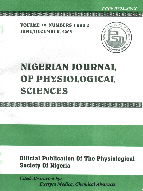
|
Nigerian Journal of Physiological Sciences
Physiological Society of Nigeria
ISSN: 0794-859X
Vol. 22, No. 1-2, 2007, pp. 59-63
|
 Bioline Code: np07010
Bioline Code: np07010
Full paper language: English
Document type: Research Article
Document available free of charge
|
|
|
Nigerian Journal of Physiological Sciences, Vol. 22, No. 1-2, 2007, pp. 59-63
| en |
CENTRAL NERVOUS SYSTEM DEPRESSANT ACTIVITY OF RUSSELIA EQUISETIFORMIS
KOLAWOLE, O. T.; MAKINDE, J. M. & OLAJIDE, O.A.
Abstract
The central nervous system depressant activity of the crude methanol extract (REC) and fractions (RE1, RE2, and RE3) of Russelia equisetiformis were evaluated in mice using the following models: amphetamine – induced stereotypy, picrotoxin – induced convulsion and phenobarbitone sleeping time. At 200-400mg/kg, REC significantly increased phenobarbitone-sleeping time (p< 0.05) in a dose- dependent manner and also reduced the sleep latency significantly (p< 0.05). The fractions, at doses 1.5mg/kg for RE1 and 20mg/kg for RE2 and RE3 also significantly prolonged Phenobarbitone sleeping time and sleep latency (p< 0.05). Picrotoxin – induced convulsion was not prevented by 100-400mg/kg of REC but this dose range significantly prolonged seizure latency. A significant reduction (p< 0.05) in amphetamine – induced stereotype behavior was observed with 200mg/kg REC, but there was no protection against amphetamine – induced mortality. The results of this study suggest that Russelia equisetiformis methanol extract possesses central nervous system depressant activities.
Keywords
Russelia equisetiformis, Phenobarbitone, stereotypy, anticonvulsant, Picrotoxin, amphetamine.
|
| |
© Copyright 2007 - Physiological Society of Nigeria
|
|
